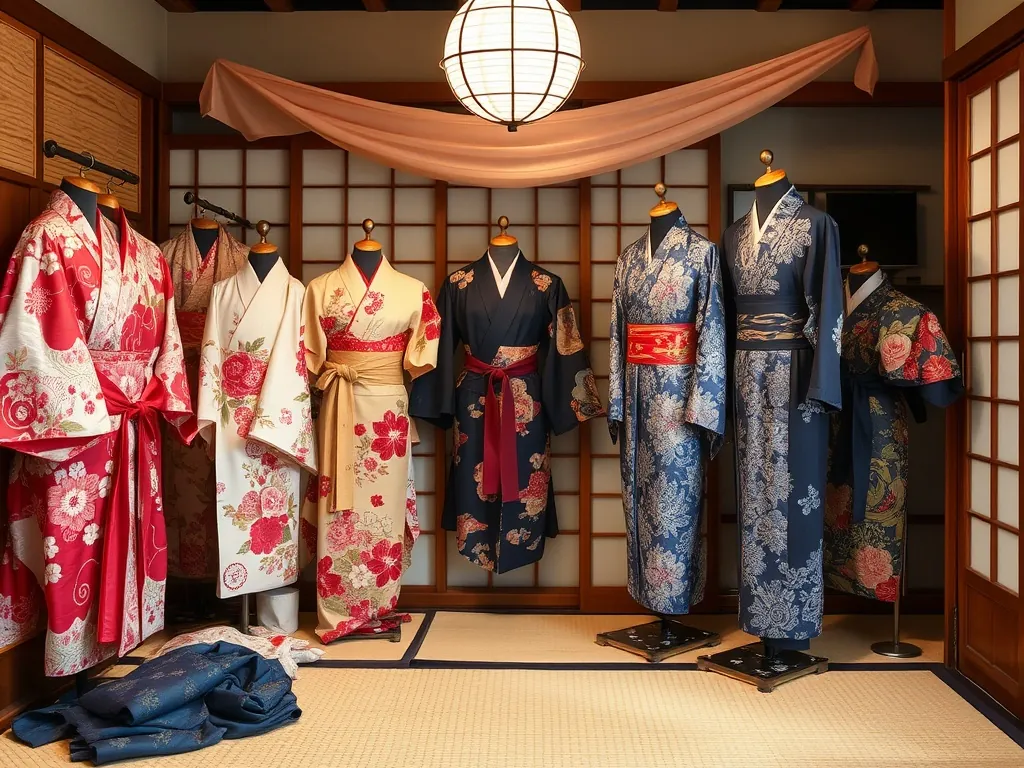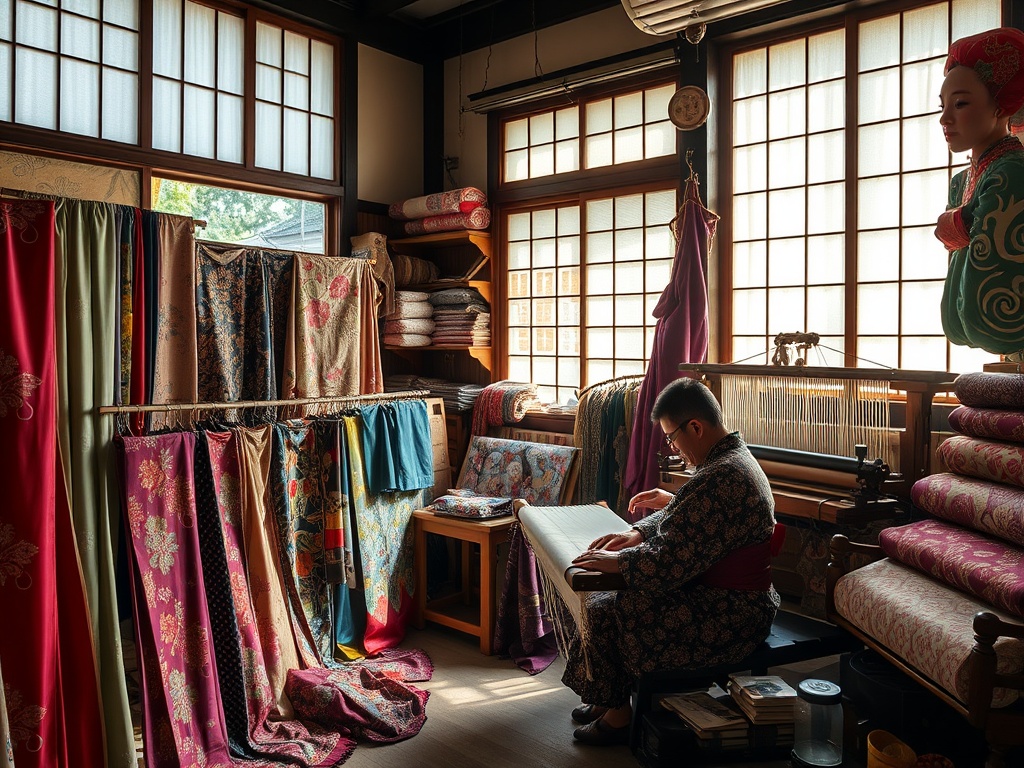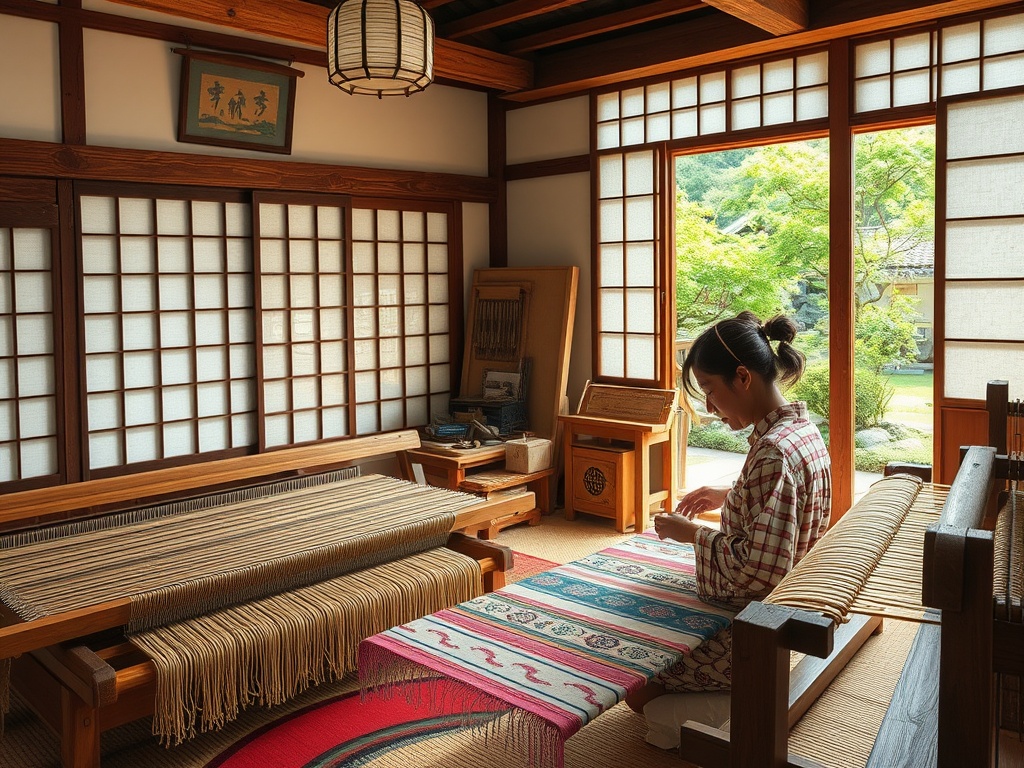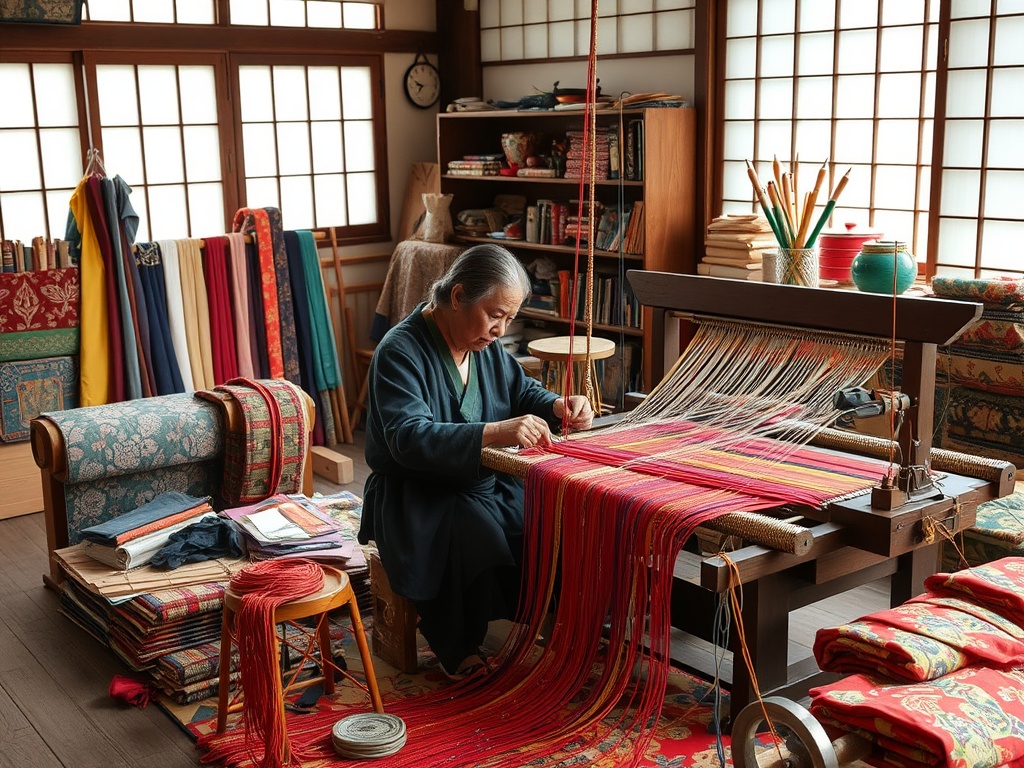Silken Dreams: Unraveling the Mystique of Kimono Fabrics
Win a Free Trip to Japan!
Experience cherry blossoms and ancient temples
The kimono, a quintessential symbol of Japanese culture, is more than just a garment; it is a canvas of history, artistry, and intricate craftsmanship. For those who venture into the world of kimono fabrics, a journey awaits filled with silken dreams and the whispers of the past. Whether you are a travel enthusiast or a cultural connoisseur, understanding the materials that bring kimonos to life will enrich your appreciation of this timeless attire.
Diving into the world of kimono fabrics reveals a mesmerizing array of textiles, each with its unique story and significance. The choice of fabric not only influences the aesthetic appeal but also reflects the season, occasion, and social status of the wearer.
- Silk (Kinran): Renowned for its luxurious sheen and delicate texture, silk remains the most prestigious material for kimonos. Often reserved for formal events, silk kimonos exude elegance and sophistication.
- Cotton (Yukata): Lightweight and breathable, cotton kimonos are popular for summer festivities. Known as ‘yukata,’ these kimonos are often adorned with vibrant patterns, capturing the essence of lively summer celebrations.
- Wool: Providing warmth and comfort, wool kimonos are ideal for cooler seasons. They are less formal but serve as a cozy option for casual gatherings.
- Hemp: With a crisp texture and natural feel, hemp kimonos offer a rustic charm. They are often used for traditional ceremonies and rural events.
Once the fabric is chosen, the next step in kimono creation is the art of dyeing and embellishment. This stage transforms plain textiles into works of art, using techniques passed down through generations.
Yuzen Dyeing: A traditional Japanese dyeing technique that involves hand-painting intricate patterns onto fabric. Often featuring motifs from nature, Yuzen-dyed kimonos are masterpieces of color and detail.
Shibori: Known as the Japanese tie-dye, Shibori involves binding, folding, and twisting fabric before dyeing. The result is a stunning array of patterns, each piece unique and unpredictable.
Embroidery: Adding texture and depth, embroidery enhances the beauty of kimono fabrics. Gold and silver threads are often used to create opulent designs that shimmer with every movement.
A Weave of History: Exploring the Tapestry of Traditional Japanese Textiles
Step into the rich tapestry of traditional Japanese textiles and discover a world where each thread tells a story of cultural heritage and the passage of time. For the travel and tourism enthusiasts yearning to delve deeper into the heart of Japanese tradition, understanding these textiles offers an intimate glimpse into the nation’s soul. As you wander through this guide, imagine yourself not just observing, but feeling the textures and emotions woven into every piece.
Textiles in Japan have long been more than mere clothing; they are a reflection of the country’s historical evolution. From the intricate silk garments worn by nobility in ancient times to the pragmatic hemp robes of rural life, these fabrics provide insights into the societal structures and lifestyles of different eras. The art of textile creation in Japan has been a continuously evolving tapestry, adapting to influences and innovations while maintaining a deep connection to its roots. Each fabric, whether displayed in museums or worn by those who continue traditional practices today, echoes the whispers of history, offering a tactile narrative that spans centuries.
In the world of Japanese textiles, symbolism is woven into the very fabric of existence. Patterns and colors are not merely aesthetic choices but carry profound meanings, often linked to nature, spirituality, and societal values. The depictions of cranes and cherry blossoms, for example, are not just visually stunning but are imbued with messages of hope, renewal, and prosperity. As you explore these textiles, consider the cultural narratives they carry, acting as visual storytellers that convey the philosophical and moral teachings cherished in Japan.
For travelers and culture aficionados, the journey through traditional Japanese textiles is an exploration of artistry and heritage, offering a tangible connection to Japan’s past and its enduring cultural legacy. Whether you’re visiting a bustling urban center or a tranquil rural village, the legacy of these textiles is an ever-present reminder of the country’s rich historical tapestry.
From Threads to Traditions: The Art of Obi Craftsmanship
Embarking on a journey through the world of Japanese textiles is an enchanting experience, and no exploration is complete without delving into the artistry of obi craftsmanship. The obi, a broad sash worn with kimonos, is not merely a functional accessory but a masterpiece that encapsulates the elegance and intricacies of Japanese culture. For travel and tourism enthusiasts, understanding the art of obi creation provides an evocative insight into the traditions that have woven through Japan’s history.
The making of an obi is a meticulous process that highlights the skill and dedication of its artisans. Each obi is a reflection of artistic vision, combining traditional techniques with a rich tapestry of cultural motifs. The process begins with the selection of fine threads, followed by weaving and dyeing methods that have been preserved through the ages.
- The Steps in Creating a Traditional Obi:
- Thread Selection: The choice of thread is crucial, with silk being the most prized for its lustrous quality. Cotton and synthetic fibers are also used for more casual obis.
- Weaving: Skilled weavers employ traditional looms to create complex patterns, ensuring each obi is a unique work of art.
- Dyeing: Techniques such as katazome (stencil dyeing) or yuzen (hand-painted dyeing) are used to impart vibrant colors and intricate designs.
- Embellishment: Embroidered elements or metallic threads are often added to enhance the obi’s visual appeal, creating a stunning interplay of textures.
The obi is not a one-size-fits-all accessory; its type and design are carefully chosen to complement the kimono and the occasion. Each style carries its own cultural significance, adding layers of meaning to this exquisite garment.
| Type of Obi | Description | Occasions |
|---|---|---|
| Fukuro Obi | A formal obi often adorned with elaborate patterns and made from silk. | Weddings, Ceremonies |
| Nagoya Obi | A versatile, easy-to-wear obi, ideal for both casual and semi-formal settings. | Tea Ceremonies, Festivals |
| Hanhaba Obi | A simpler, narrower obi, perfect for informal gatherings and daily wear. | Casual Outings, Summer Festivals |
For those drawn to the world of Japanese fashion, exploring the art of obi craftsmanship is a gateway to understanding the deeper cultural narratives and timeless elegance that define this iconic accessory. Whether you’re visiting a kimono shop in Kyoto or attending a traditional festival, the obi stands as a testament to the enduring legacy of Japanese textile artistry.
Nature’s Palette: Discovering the Vibrant Dyes of Japan’s Garments
In the realm of Japanese traditional attire, the dazzling array of colors is both an art and a science, capturing the essence of nature’s beauty within the fabric. These vibrant dyes are not just hues but are steeped in history and cultural significance, offering travelers a vivid insight into the craftsmanship and environmental harmony cherished by Japan. As you explore the tapestry of Japanese garments, you’ll uncover a world where every shade tells a story, inviting you to delve deeper into the cultural tapestry of this fascinating nation.
The practice of natural dyeing in Japan is a testament to the country’s reverence for nature. Utilizing plants, flowers, and minerals, artisans have perfected the art of extracting vibrant colors that are both breathtaking and sustainable. Indigo, known as ‘ai’, is perhaps the most iconic of these dyes, celebrated for its deep, rich blues that evoke the serenity of the Japanese landscape. The process of indigo dyeing is intricate, involving fermentation and repeated dipping to achieve the desired hue. This ancient technique not only produces stunning textiles but also symbolizes purity and protection in Japanese culture.
Another prized dye is benibana or safflower red, which produces a range of shades from soft pinks to vivid reds. Traditionally used for kimono linings and ceremonial garments, benibana is cherished for its gentle warmth and its ability to convey emotions of love and celebration. Derived from the petals of the safflower, the dyeing process is labor-intensive, reflecting the artistry and patience inherent in Japanese textile traditions.
Beyond their aesthetic appeal, these natural dyes carry profound cultural narratives. The colors are often linked to specific seasons, events, and societal roles, making each garment a canvas of stories and meanings. For instance, the muted tones of browns and greens often signify humility and connection to the earth, while brighter colors such as yellows and purples are associated with nobility and celebration.
Today, there is a renaissance in the appreciation of natural dyes, as contemporary designers and artisans seek to revive these traditional methods. This modern revival not only honors the past but also aligns with global movements towards sustainable and eco-friendly fashion. Visitors to Japan can witness this resurgence firsthand by attending workshops or visiting artisans’ studios, where the delicate balance between tradition and innovation is on full display. These experiences offer a unique opportunity to connect with the soul of Japanese culture and to appreciate the enduring beauty of nature’s palette.
Cultural Threads: The Symbolism and Stories Woven into Japanese Dress
For those captivated by the allure of Japanese culture, exploring the symbolism embedded within traditional garments unveils a rich tapestry of stories and meanings. As you dive deeper into this fascinating aspect of Japanese attire, you’ll discover how each piece is not merely a fabric but a narrative that speaks of history, belief, and identity. These garments are imbued with the essence of the past, offering travelers an opportunity to connect with Japan’s soul through its distinctive dress.
In the realm of Japanese traditional dress, patterns are more than decorative elements; they are a language that tells stories of the land, the seasons, and the beliefs of its people. Motifs such as cranes, turtles, and plum blossoms are common, each carrying symbolic significance rooted in folklore and tradition. The crane, for instance, is a symbol of longevity and good fortune, often featured in wedding kimonos to bestow blessings upon the newlyweds. Similarly, the plum blossom, which blooms in the winter, signifies resilience and hope, reminding the wearer of strength during adversity.
The choice of patterns is not arbitrary but carefully selected to reflect the occasion and the wearer’s aspirations. Seasonal motifs are particularly prevalent, with cherry blossoms heralding spring and maple leaves celebrating autumn. As you explore these garments, you begin to understand how Japanese dress serves as a visual storytelling medium, conveying emotions and values through its design.
Color plays a pivotal role in Japanese dress, with each hue resonating with cultural significance. The vibrant reds and deep blues are not merely aesthetic choices but are imbued with meaning that echoes through history. Red, often associated with life and energy, is a popular choice for children’s clothing and celebratory garments, while blue, derived from the indigo dye, symbolizes protection and steadfastness.
The subtle art of selecting colors is a reflection of the wearer’s relationship with their environment and the social context of the occasion. White, for example, is both a color of purity and mourning, demonstrating the duality of meanings that colors can convey. By understanding these nuances, travelers can gain a deeper appreciation of the cultural narratives that are woven into each garment, transforming their experience of Japanese traditional dress into a journey through the nation’s rich heritage.
Stitching through Time: The Evolution of Japanese Attire Materials
For those eager to immerse themselves in the cultural depths of Japan, a journey through the evolution of its traditional dress materials offers a fascinating glimpse into the nation’s past. As you delve into this realm, you’ll find that Japan’s textiles are more than just fabrics; they are threads that weave a continuous narrative of innovation, adaptation, and artistry.
Throughout history, the materials used in Japanese attire have transitioned from purely functional to highly artistic expressions. In ancient times, practicality and availability dictated the choice of materials, with hemp and bark cloth providing durable options for everyday wear. As Japan’s cultural and economic landscape evolved, so too did its textiles. The introduction of silk during the Yayoi period marked a significant shift, transforming attire into a symbol of luxury and status. The silk trade flourished, and with it, the art of sericulture spread across the country, giving rise to exquisite garments that reflected the wearer’s social standing.
As you explore the rich tapestry of Japanese dress materials, consider the profound impact of foreign influences and technological advancements. The Meiji era, in particular, was a time of dynamic change, where Western materials and techniques began to blend with traditional practices, resulting in a unique fusion of styles. This period of experimentation and adaptation laid the groundwork for modern Japanese fashion, where traditional elements are continually reimagined for contemporary tastes.
In the present day, the evolution of Japanese attire materials is a testament to the nation’s ability to honor its heritage while embracing modernity. The resurgence of natural fibers such as organic cotton and sustainable silks reflects a growing appreciation for eco-friendly practices and traditional craftsmanship. These materials are celebrated not only for their aesthetic qualities but also for their connection to the earth and the artisans who create them.
Travelers with a keen interest in the intersection of tradition and innovation will find much to marvel at in Japan’s textile industry. From the bustling markets of Kyoto to the serene workshops in rural villages, the story of Japanese attire materials continues to unfold. By engaging with artisans and experiencing the tactile beauty of these fabrics, visitors can gain a deeper understanding of how Japan seamlessly stitches its past into the fabric of its future.



